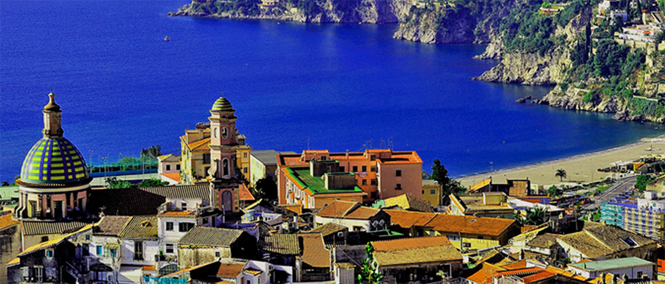CTA Salerno

Province of Salerno- Italy
Population: 8,328
Vietri sul Mare, the first town when travelling west along the Amalfi Coast from Salerno, was
declared to be a World Heritage Site by UNESCO in 1997.
Vietri sul Mare is historically identified with the ancient Marcina, formerly an Etruscan coastal
settlement and later a Roman harbour.
The area of Vietri was a secure port thanks to its Fuenti anchorage which guaranteed a safe
approach to the dock, a rarity in the surrounding area. Vietri therefore represented an ideal trading
site for the Etruscan settlers.
Vietri was a district of the city of Cava De’ Tirreni, in the Principality of Salerno which was at the
time a part of the Kingdom of Naples. Marina di Vietri was in fact used as a trading port by the
monks of the Badia, the Abbey of Cava, especially for trading with the areas South of Salerno.
The history of the two cities is therefore linked until 1806, when Vietri gained its full autonomy.
In 1944, when Salerno became the capital of Italy for a few months, the king Vittorio Emanuele
lived in the nearby Villa Guariglia, which was located in the village of Raito.
Vietri is surrounded by several residential areas: Marina, the first beach of the Amalfi Coast,
followed by Molina, named after the Italian word ‘mulini’, the mills which in the Middle Ages were
standing on the Bonea river; Albori, member of the Club of “Italy's Finest Villages” (created by
the The National Association of Italian Municipalities (ANCI)); Raito, a village overlooking the
Gulf of Salerno, named after the Latin word "ragitus" which means “kissed by the sun” because of
its good exposition; and Benincasa and Dragonea, from which several mountain trails originate.
Vietri’s fame in Italy and all over the world is connected to its ceramic industry, which has its roots
in the Etruscan period.
Monuments and Places of Interest
• The Parrocchia di San Giovanni Battista is a parish erected in the seventeenth century in
Neapolitan late-Renaissance style. It has a majestic ceramic dome and it is characterised by
a double crowning of the bell tower cusp in painted ceramics; on top of the portal there is
an oculus, a small opening which was walled in the twentieth century to contain the image
of the Patron Saint also painted on ceramics. Inside, the church has a single aisle and altars
which are decorated with majolica and ceramics, apart from the Major Altar, which was
built using marble. Of great interest the paintings which go back to the seventeenth up to the
fifteenth century.
• The Arciconfraternita della SS Annunziata e del SS. Rosario, a confraternity built in the
eighteenth century. Its facade is decorated with painted ceramics.
• Chiesa di S.Antonio da Padova (1607), a church in Marina di Vietri.
• Chiesa della Madonna dell’Arco, a church situated on a little street with the same name
which connects Marina di Vietri sul Mare to the Amalfi Coast.
• Chiesa di S. Margherita di Antiochia, a church in the hamlet of Albori.
• Oratorio della Congrega di San Francesco di Paola, an oratory situated in Albori with a
ceramic floor which dates back to 1864.
• Chiesa parrocchiale di Raito (1540), a parish church in Raito village dedicated to Santa
Maria delle Grazie.
• Chiesa parrocchiale di Santa Maria delle Grazie, a parish church in the hamlet of Benincasa
which houses a statue and ‘la salvietta’, a parchment with the face of S.Francesco di Paola
imprinted on it.
• Chiesa parrocchiale di S.Pietro Apostolo, a parish church in the hamlet of Dragonea.
• Santuario San Vincenzo Ferreri, a sanctuary in Dragonea.
• Chiesa della Madonna della Neve a Molina, a church in the hamlet of Molina.
• Ponte di Molina, the bridge of Molina - you can see the ruins of the Traverse bridge which
was built in the first half of the fourteenth century to support the aqueduct later called ‘dei
diavoli’ the devils ‘aqueduct, which was destroyed by the big flood of 1954.
• Villa Guariglia, in Raito Village.
• Torretta Belvedere, a tower in Raito Village (Provincial Museum of Ceramics).
• Torre-dogana, a tower in Marina di Vietri.
• Terma Romana in Marina di Vietri, Roman thermal baths part of a building complex
currently used as a restaurant.
• The Palazzo “Soleri”, which houses the Ceramica artistica Vincenzo Solimene, a company
which produces handmade ceramics. The building is an example of a post World War
II organic architecture, it was designed by Paolo Soleri and it hosts a vast collection of
contemporary ceramics.
• Palazzo della Guardia (1731), the Guards building.
• Villa Comunale, the communal park in Vietri Sul Mare.
Other places of interest are: the path which connects the high hamlets of Raito and Albori with the
local natural springs (Fonte del Cesare), the path which connects the high hamlets of Dragonea with
the Cava de’ Tirreni’s valley and the Badia, and the Avvocatella and Avvocata walks.











